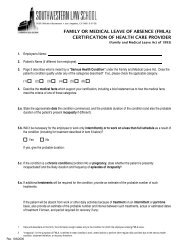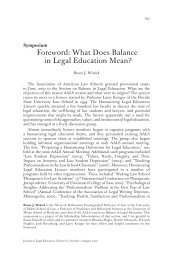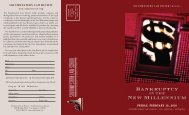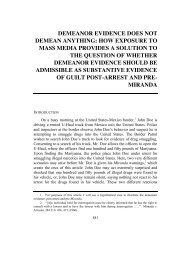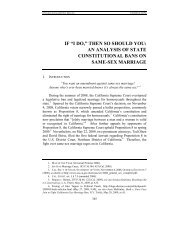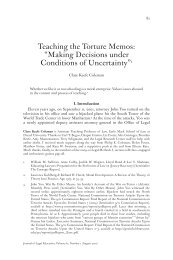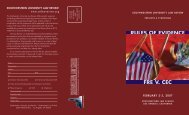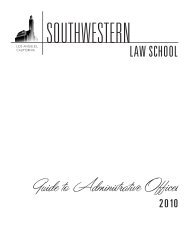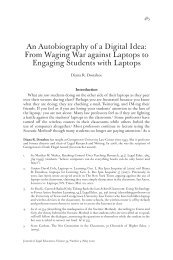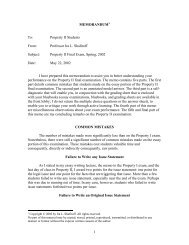What is Art? - Southwestern Law School
What is Art? - Southwestern Law School
What is Art? - Southwestern Law School
- No tags were found...
You also want an ePaper? Increase the reach of your titles
YUMPU automatically turns print PDFs into web optimized ePapers that Google loves.
WHAT IS ART? 117box. The concept of the celestial jukebox <strong>is</strong> exemplified by Spotify:rather than delivering a music file for retention by the subscriber (aswith iTunes), material <strong>is</strong> streamed on demand to the user—literally,a jukebox via satellite transm<strong>is</strong>sion.F. International ReciprocityIn 1886, at the height of the Industrial Revolution, developed nationspromulgated the Berne Convention. 20 Th<strong>is</strong> seminal internationalagreement (and its subsequent rev<strong>is</strong>ions throughout the 20th century)addressed two key problems relating to the worldwide enforcementof copyright: each signatory country’s copyright leg<strong>is</strong>lation was differentto the others, and was not enforceable beyond its own jur<strong>is</strong>dictionalboundaries. Signatories undertook to amend their domestic leg<strong>is</strong>lation: toprovide minimum standards for domestic/national copyright law; and torecognize and enforce the copyright works of authors from other signatorycountries, as they did for their own authors. The Berne Convention’sinternational harmon<strong>is</strong>ation and reciprocal enforcement of copyrightlaws provided a model for subsequent international intellectual propertytreaties throughout the 20th century, to date. 21However, international agreements encounter common language andtranslation <strong>is</strong>sues, especially when seeking to describe or define art.Diplomatic comprom<strong>is</strong>es and concessions are made to achieve agreement,often producing bland or ambiguous treaty prov<strong>is</strong>ions. Internationalagreements concerning copyright generally permit each signatorycountry itself to interpret and/or define any legal meaning of art withinits own national leg<strong>is</strong>lation. For example, the Berne Convention initiallydescribes “art<strong>is</strong>tic works” as follows: “every production in the art<strong>is</strong>ticdomain, whatever may be the mode or form of its expression”; thencontinues by specifying an inclusionary l<strong>is</strong>t of art forms: “such asworks of drawing, painting, architecture, sculpture, engraving and lithography;photographic works to which are assimilated works expressedby a process analogous to photography; works of applied20. The Berne Convention for the Protection of Literary and <strong>Art</strong><strong>is</strong>tic Works (1886)(hereinafter “Berne Convention”), http://www.wipo.int/treaties/en/ip/berne/trtdocs_wo001.html The UK joined the Berne Union in 1887, the U.S. in 1989; by 2011there were 164 member countries. See also http://www.wipo.int/treaties/en/ip/berne/.21. See Universal Copyright Convention (1952), http://www.wipo.int/wipolex/en/other_treaties/text.jsp?file_id=172836; Universal Copyright Convention (1971),http://portal.unesco.org/en/ev.php-URL_ID=15241&URL_DO=DO_TOPIC&URL_SECTION=201.html; Agreement on Trade-Related Aspects of Intellectual PropertyRights (TRIPS) (1994), http://www.wto.org/engl<strong>is</strong>h/docs_e/legal_e/27-trips.pdf; andthe World Intellectual Property Organization (WIPO), Copyright Treaty (Dec. 20,1996), www.wipo.int/treaties/en/ip/wct/trtdocs_wo033.html.



